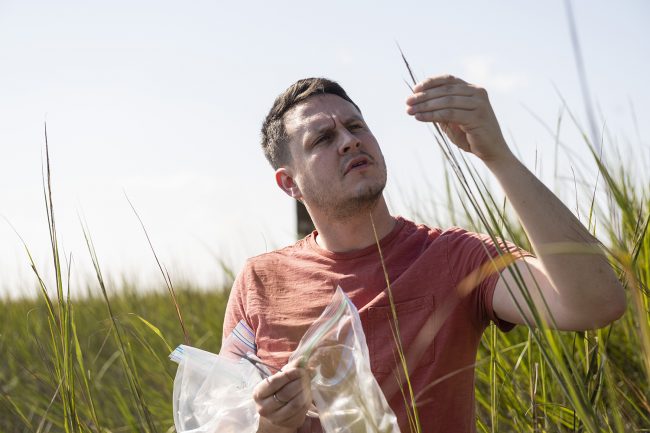
Salt marshes in south Georgia are in constant need of restoration due to rising sea levels. Georgia Southern University graduate student Alexander Gregory is leading a project on the Armstrong Campus to address the loss of marsh habitats by researching Spartina alterniflora, the dominant plant in Georgia salt marshes.
Gregory, along with Sustainable Aquaponics Research Center (SARC) Senior Scientist Heather Joesting, Ph.D., is building an aquaponics garden to research the ideal growth conditions of Spartina in order to eventually become the first producer of locally-grown Spartina for Georgia marsh restoration projects.
“Spartina is often planted as part of salt marsh restoration projects to stabilize and capture sediment, but there is no local, Georgia source for these plants so coastal managers must purchase them from out-of-state plant nurseries,” Joesting said. “Salt marsh habitats provide numerous ecosystem services, including coastal protection from storms, carbon sequestration and maintenance of commercial fisheries. Spartina is critical in stabilizing and accumulating sediment to facilitate marsh horizontal and vertical growth.”
Like the current aquaponics garden on the Armstrong Campus in Savannah that is used to grow vegetables, the garden uses fish waste to fertilize the Spartina, which is grown in water. The water is then cleaned by the plants and recirculated into the fish tank. Due to the versatility of Spartina, the garden will be able to use freshwater or marine fish in the growing process, which will cut the cost of buying salt to maintain fish growing conditions in marine aquaculture.
The project, which encompasses a multitude of scientific disciplines and research techniques, has so far provided seven undergraduate research students with experience in field and lab data collection, as well as other research skills that will be relevant to their post-graduation goals.
“This project incorporates information I’ve learned in courses like organic chemistry, plant biology and microbiology, just to name a few,” Gregory said. “There are so many organisms involved in this project, which is key to ecology. We want to understand all of the abiotic and biotic factors that are interacting to create the conditions we see. The knowledge that I brought with me at the beginning of this project pales in comparison to the knowledge I have gained actively planning and executing the work for it.”
While the research on the Spartina garden has been going on since last fall, there is still work to be done on the project. The team is currently monitoring plant survival and finishing completing the fish-garden recirculating system at the aquaponics facility on the Armstrong Campus. This summer the team will collect data in the garden and complete analyses in the lab.

Graduate student Alexander Gregory works with a team of undergraduate researchers to collect Spartina samples in Savannah. / Credit: GSU
Gregory said the project has the potential to make a large impact on various scientific industries, such as conservation, living shorelines, aquaculture, traditional nursery practices, environmental biology and chemistry. He hopes to use the multidisciplinary aspects of the project in the next step of his professional or academic career.
“I think this project will have some pretty big implications for conservation of our salt marshes in Georgia and the economic and environmental costs of aquaculture,” Gregory said. “I think that the way this project ties together so many different threads is really amazing. I hope by the end of this project I have touched on and used competencies from many of these fields so that I can either get into a Ph.D. program or make myself a strong contender for the jobs that are out there.”
For more information on SARC at Georgia Southern University, visit cosm.georgiasouthern.edu/sarc/.
Source: GSU


Chattooga Opinions
The Joy of the Journey: The Hope of Christmas

Bulloch Public Safety
Several Arrested in Bulloch for Narcotics Trafficking After Citizen Complaints

Bulloch Public Safety
12/19/2025 Booking Report for Bulloch County

Chattooga Local News
Trump signs executive order reclassifing marijuana

Bulloch Public Safety
11/24/2025 Booking Report for Bulloch County

Bulloch Public Safety
12/12/2025 Booking Report for Bulloch County

Bulloch Public Safety
12/01/2025 Booking Report for Bulloch County

Bulloch Public Safety
12/16/2025 Booking Report for Bulloch County

Bulloch Public Safety
12/11/2025 Booking Report for Bulloch County







